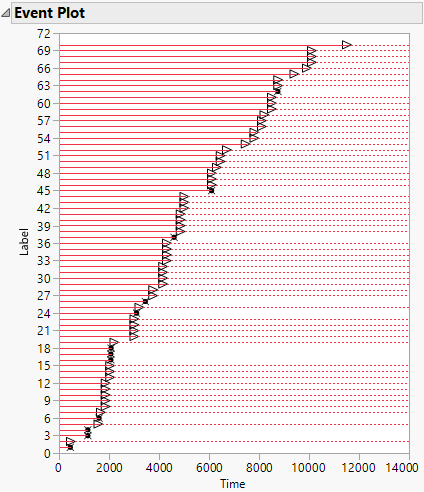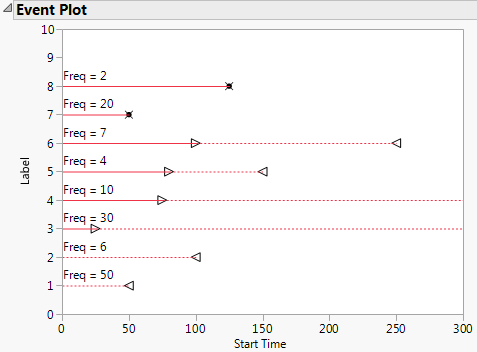Event Plot
Click the Event Plot disclosure icon to see a plot of the failure or censoring times. For each row in the data table, the Event Plot shows a horizontal line indicating whether the units in the row have been censored. When units have been censored, the line indicates the nature of the censoring.
• The time period when the units in the row are known to be functioning is indicated with a solid line.
• The time period when it is not known if the units in the row are functioning is indicated with a dashed line.
• The line terminates once the units in the row are known to have failed.
Single Time to Event Column
In the Fan.jmp sample data table there is a single Time column indicating failure time. When the failure time is unknown, the value Censored is recorded in the Censor column. All censored units are assumed to be right-censored. Figure 3.7 shows the Event Plot for this data.
Note: To construct the plot in Figure 3.7, select Help > Sample Data Folder and open Reliability/Fan.jmp. Click the green triangle next to the Life Distribution - Exponential script. Click the Event Plot disclosure icon.
Figure 3.7 Event Plot for Right-Censored Data
The unit in row 3 failed at Time 1150. Its lifetime is represented by a solid horizontal line that ends at Time 1150. The failure time is marked with an “x”.
The unit in row 5 is right censored. It was last know to be functioning at Time 1560. The time period during which the unit is known to be functioning is represented by a solid horizontal line that ends at Time 1560. At Time 1560, a right arrow is plotted. The line continues as a dashed line, indicating that the failure time is unknown, but greater than 1560.
Two Time to Event Columns
In the Censor Labels.jmp sample data table, there are two columns, Start Time and End Time. Start Time indicates when units in a row were last known to be functioning. End Time indicates when units in that row were first known to have failed.
The Start Time and End Time values indicate the following about the units:
• Units in rows 1 and 2 are left censored. They were known to fail before the time in the End Time column, but their exact failure times are unknown.
• Units in rows 3 and 4 are right censored. They were known to be last functioning at the time in the Start Time column, but their failure times are unknown.
• Units in rows 5 and 6 are interval censored. They were known to fail within the interval defined by the Start Time and End Time.
• Units in rows 7 and 8 are not censored. Their failure times are given by the values in the Start Time and End Time columns, which are identical.
Figure 3.8 shows the Event Plot for this data.
Note: To construct the plot in Figure 3.8, select Help > Sample Data Folder and open Censor Labels.jmp. Click the green triangle next to the Life Distribution script.
Figure 3.8 Event Plot for Mixed-Censored Data
The line patterns in the Event Plot represent the various types of censoring:
• The pattern  indicates right censoring. The unit failed after its last inspection.
indicates right censoring. The unit failed after its last inspection.
• The pattern  indicates left censoring. The unit failed after being put on test and prior to the indicated time, but it is not known when it was last functioning.
indicates left censoring. The unit failed after being put on test and prior to the indicated time, but it is not known when it was last functioning.
• The pattern  indicates that the unit failed during the time interval marked by the two arrow heads.
indicates that the unit failed during the time interval marked by the two arrow heads.
• The pattern  indicates no censoring. The unit failed at the time marked by the x.
indicates no censoring. The unit failed at the time marked by the x.

